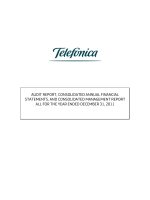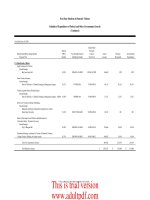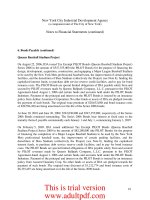02 financial statements and analysis
Bạn đang xem bản rút gọn của tài liệu. Xem và tải ngay bản đầy đủ của tài liệu tại đây (1.58 MB, 56 trang )
Chapter 2
Financial
Statements
and Analysis
Learning Goals
1. Review the contents of the stockholders’ report
and the procedures for consolidating
international financial statements.
2. Understand who uses financial ratios,
and how.
3. Use ratios to analyze a firm’s liquidity
and activity.
4. Discuss the relationship between debt and
financial leverage and the ratios used to
analyze a firm’s debt.
Copyright © 2006 Pearson Addison-
2-2
Learning Goals (cont.)
5. Use ratios to analyze a firm’s profitability
and market value.
6. Use a summary of financial ratios and
the DuPont system of analysis to
perform a complete ratio analysis.
Copyright © 2006 Pearson Addison-
2-3
The Stockholders’ Report
• The guidelines used to prepare and maintain financial
records and reports are known as generally accepted
accounting principles (GAAP).
• GAAP is authorized by the Financial Accounting
Standards Board (FASB).
• The Sarbanes-Oxley Act of 2002, passed to eliminate
the many disclosure and conflict of interest problems of
corporations, established the Public Company
Accounting Oversight Board (PCAOB), which is a notfor-profit corporation that overseas auditors.
Copyright © 2006 Pearson Addison-
2-4
The Stockholders’ Report (cont.)
• The PCAOB is charged with protecting the
interests of investors and furthering the public
interest in the preparation of informative, fair,
and independent audit reports.
• Public corporations with more than
$5 million in assets and more than 500
stockholders are required by the SEC to
provide their stockholders with an annual
stockholders report.
Copyright © 2006 Pearson Addison-
2-5
The Four Key Financial Statements:
The Income Statement
• The income statement provides a financial
summary of a company’s operating results
during a specified period.
• Although they are prepared annually for
reporting purposes, they are generally
computed monthly by management and
quarterly for tax purposes.
Copyright © 2006 Pearson Addison-
2-6
The Four Key
Financial
Statements
Copyright © 2006 Pearson Addison-
2-7
The Four Key Financial Statements:
The Balance Sheet
• The balance sheet presents a summary of
a firm’s financial position at a given point
in time.
• Assets indicate what the firm owns,
equity represents the owners’ investment,
and liabilities indicate what the firm
has borrowed.
Copyright © 2006 Pearson Addison-
2-8
The Four Key Financial Statements
Copyright © 2006 Pearson Addison-
2-9
The Four Key
Financial Statements (cont.)
Copyright © 2006 Pearson Addison-
2-10
The Four Key Financial Statements:
Statement of Retained Earnings
• The statement of retained earnings
reconciles the net income earned and
dividends paid during the year, with the
change in retained earnings.
Copyright © 2006 Pearson Addison-
2-11
The Four Key Financial Statements
Copyright © 2006 Pearson Addison-
2-12
The Four Key Financial Statements:
Statement of Cash Flows
• The statement of cash flows provides a
summary of the cash flows over the period
of concern, typically the year just ended.
• This statement not only provides insight
into a company’s investment, financing
and operating activities, but also ties
together the income statement and
previous and current balance sheets.
Copyright © 2006 Pearson Addison-
2-13
The Four Key Financial Statements
Copyright © 2006 Pearson Addison-
2-14
Consolidating International
Financial Statements
• FASB 52 mandated that U.S. based companies translate
their foreign-currency denominated assets
and liabilities into dollars using the current rate
(translation) method.
• Under the translation method, companies translate all
foreign-currency-denominated assets and liabilities into
dollars at the exchange rate prevailing at the fiscal year
ending date (the current rate).
• Income statement items are usually treated similarly.
Copyright © 2006 Pearson Addison-
2-15
Consolidating International
Financial Statements (cont.)
• Equity accounts, on the other hand, are
translated into dollars by using the
exchange rate that prevailed when the
parent’s equity investment was made (the
historical rate).
• Retained earnings are adjusted to reflect
each year’s operating profits (or losses).
Copyright © 2006 Pearson Addison-
2-16
Using Financial Ratios:
Interested Parties
• Ratio analysis involves methods of
calculating and interpreting financial ratios
to assess a firm’s financial condition
and performance.
• It is of interest to shareholders, creditors,
and the firm’s own management.
Copyright © 2006 Pearson Addison-
2-17
Using Financial Ratios:
Types of Ratio Comparisons
• Trend or time-series analysis
– Used to evaluate a firm’s performance
over time
Copyright © 2006 Pearson Addison-
2-18
Using Financial Ratios:
Types of Ratio Comparisons (cont.)
• Trend or time-series analysis
• Cross-sectional analysis
– Used to compare different firms at the same
point in time
Copyright © 2006 Pearson Addison-
2-19
Using Financial Ratios:
Types of Ratio Comparisons (cont.)
• Trend or time-series analysis
• Cross-sectional analysis
– Industry comparative analysis
• One specific type of cross sectional analysis.
Used to compare one firm’s financial performance
to the industry’s average performance
Copyright © 2006 Pearson Addison-
2-20
Using Financial Ratios:
Types of Ratio Comparisons (cont.)
• Trend or time-series analysis
• Cross-sectional analysis
– Benchmarking
• A type of cross sectional analysis in which the
firm’s ratio values are compared to those of a key
competitor or group of competitors that it wishes
to emulate
Copyright © 2006 Pearson Addison-
2-21
Using Financial Ratios:
Types of Ratio Comparisons (cont.)
• Trend or time-series analysis
• Cross-sectional analysis
• Combined Analysis
– Combined analysis simply uses a
combination of both time series analysis and
cross-sectional analysis
Copyright © 2006 Pearson Addison-
2-22
Using Financial Ratios:
Types of Ratio Comparisons (cont.)
Copyright © 2006 Pearson Addison-
2-23
Using Financial Ratios:
Types of Ratio Comparisons (cont.)
Copyright © 2006 Pearson Addison-
2-24
Using Financial Ratios:
Cautions for Doing Ratio Analysis
• Ratios must be considered together; a single
ratio by itself means relatively little.
• Financial statements that are being compared
should be dated at the same point in time.
• Use audited financial statements when possible.
• The financial data being compared should have
been developed in the same way.
• Be wary of inflation distortions.
Copyright © 2006 Pearson Addison-
2-25









